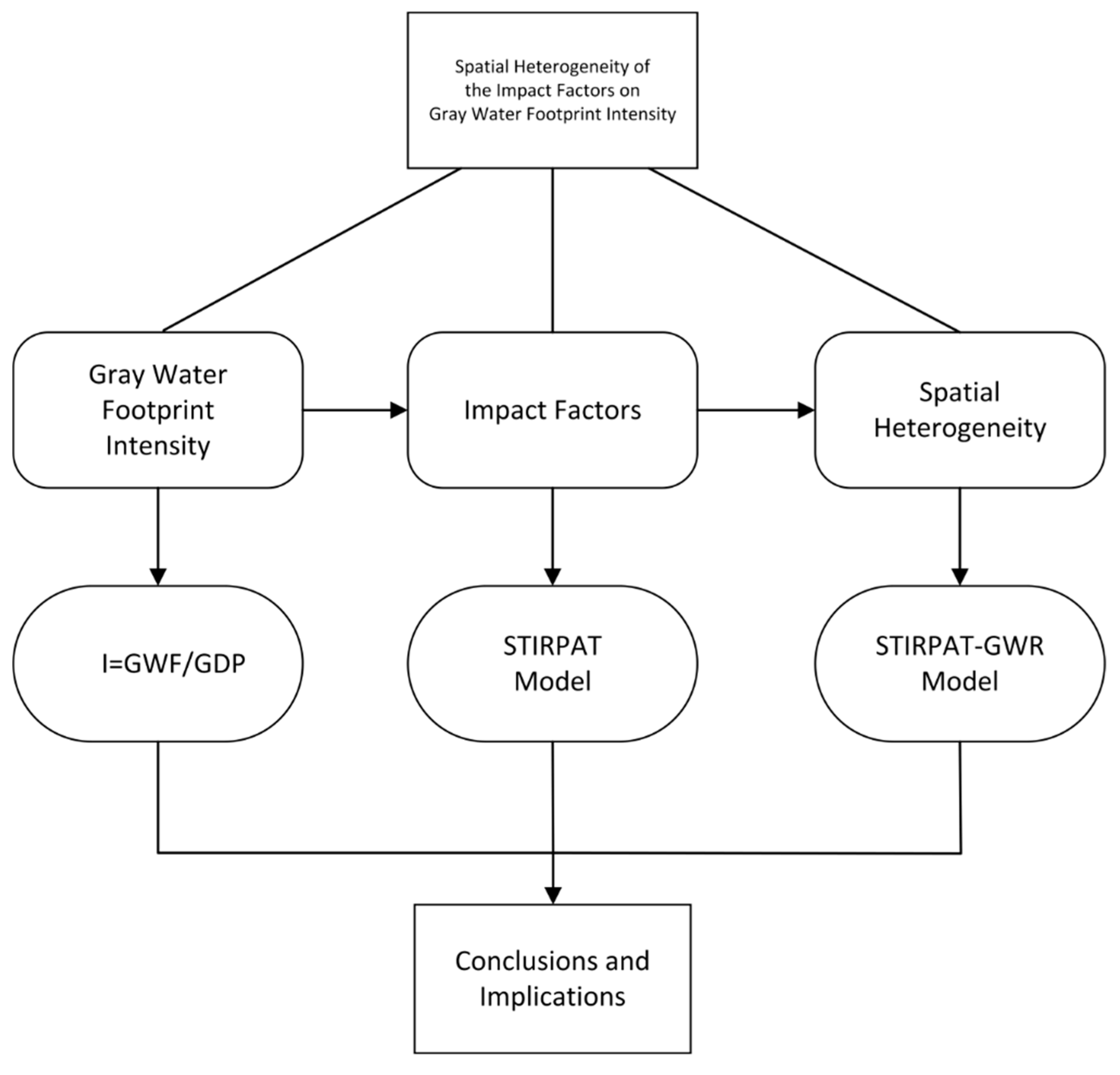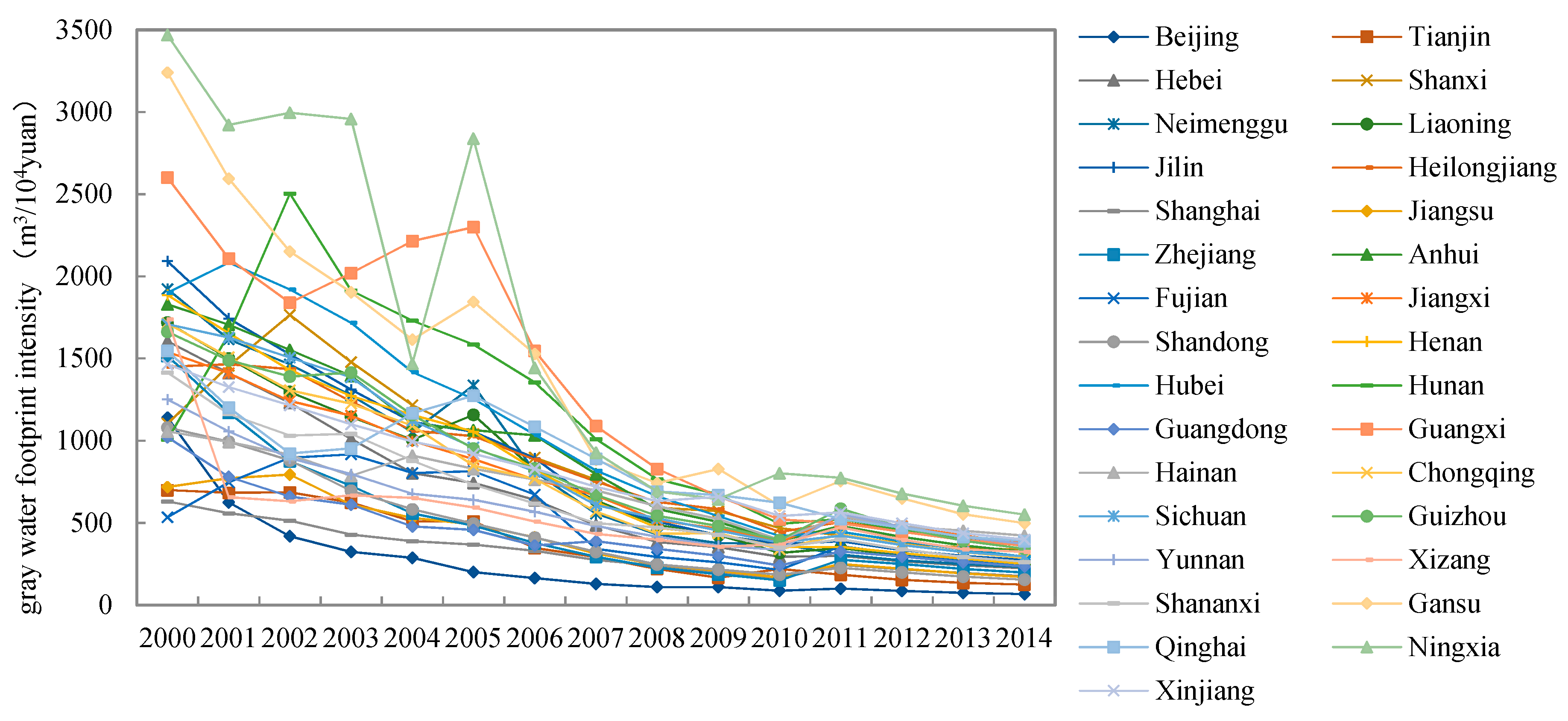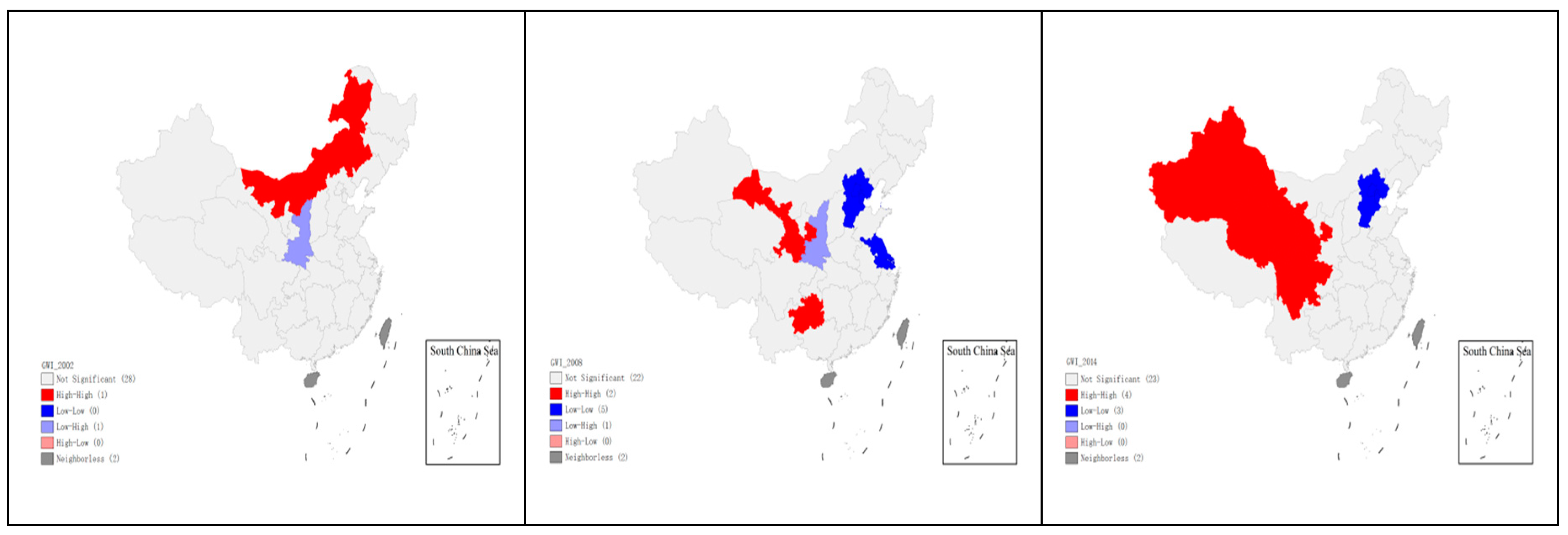Spatial Heterogeneity of the Impact Factors on Gray Water Footprint Intensity in China
Abstract
1. Introduction
- (1)
- How to measure the intensity of gray water footprint in China’s 31 provinces?
- (2)
- What are the factors affecting the intensity of gray water footprint in China’s 31 provinces?
- (3)
- What are the spatial heterogeneity characteristics of these influencing factors?
2. Methodology
2.1. Research Framework
2.2. Gray Water Footprint Calculation Method
2.2.1. Gray Water Footprint of Different Receiving Water
2.2.2. Gray Water Footprint on the Surface
2.2.3. Gray Water Footprint Subsurface
2.2.4. Gray Water Footprint Total
2.2.5. Gray Water Footprint Intensity
2.3. Spatial Econometrics
2.3.1. Spatial Autocorrelation
Space Weight Matrix
Global Moran’s I Index
Local Moran’s I Index
2.3.2. Spatial Heterogeneity
2.4. STIRPAT Model
2.5. STIRPAT Geographic Weighted Regression Model
2.6. Ridge Regression Method
2.7. Data Sources
3. Results and Discussions
3.1. Chinese Gray Water Footprint Intensity Results and Analysis
3.2. Spatial Correlation Analysis of Chinese Gray Water Footprint Intensity
3.2.1. Global Spatial Autocorrelation Analysis
3.2.2. Local Spatial Autocorrelation Analysis
3.3. Spatial Heterogeneity of the Impact Factors on Gray Water Footprint Intensity in China
3.3.1. Selection of Influencing Factors
3.3.2. Establish STIRPAT Model
3.3.3. Least Squares Regression Results
3.3.4. Ridge Regression Fitting Results
3.3.5. Analysis of Model Test Results
3.3.6. Analysis of Impact Factors
3.4. STIRPAT-GWR Model Test
3.5. Spatial Heterogeneity of the Impact Factors
3.5.1. Spatial Heterogeneity of the Impact of Total Population on Gray Water Footprint Intensity
3.5.2. Spatial Heterogeneity of the Impact of Urbanization Rate on Gray Water Footprint Intensity
3.5.3. Spatial Heterogeneity of the Impact of Output Value per Capita on Gray Water Footprint Intensity
3.5.4. Spatial Heterogeneity of the Impact of Tertiary Industry Share on Gray Water Footprint Intensity
3.5.5. Spatial Heterogeneity of the Impact of Environmental Pollution Control Intensity on Gray Water Footprint Intensity
3.5.6. Spatial Heterogeneity of the Impact of R&D Investment Intensity on Gray Water Footprint Intensity
4. Conclusions and Implications
Author Contributions
Funding
Conflicts of Interest
References
- Shahpouri, A.; Biabi, H.; Abolhassani, L. Economic development and environmental quality: The environmental Kuznets curve for water pollution. J. Appl. Sci. Environ. Manag. 2016, 20, 161–169. [Google Scholar] [CrossRef][Green Version]
- Cazcarro, I.; Duarte, R.; Sanchez Choliz, J. Downscaling the gray water footprints of production and consumption. J. Clean. Prod. 2016, 132, 171–183. [Google Scholar] [CrossRef]
- Hoekstra, A.Y.; Mekonnen, M.M. The water footprint of humanity. Proc. Natl. Acad. Sci. USA 2011, 109, 3232–3237. [Google Scholar] [CrossRef] [PubMed]
- Zhang, F.; Zhang, Q.; Li, F.; Fu, H.Y.; Yang, X.H. The spatial correlation pattern of water footprint intensity and its driving factors in China. J. Nat. Resour. 2019, 34, 934–944. [Google Scholar]
- Anselin, L. Spatial Econometrics: Methods and Models; Kluwer Academic: Boston, MA, USA, 1988. [Google Scholar]
- Hoekstra, A.Y.; Chapagain, A.K. Water footprints of nations: Water use by people as a function of their consumption pattern. Water Resour. Manag. 2007, 21, 35–48. [Google Scholar] [CrossRef]
- Chapagain, A.K.; Hoekstra, A.Y. The blue, green and gray water footprint of rice from production and consumption perspectives. Ecol. Econ. 2011, 70, 749–758. [Google Scholar] [CrossRef]
- Chapagain, A.K.; Hoekstra, A.Y.; Savenije, H.H. Water saving through international trade of agricultural products. Hydrol. Earth Syst. Sci. 2006, 10, 455–468. [Google Scholar] [CrossRef]
- Ruini, L.; Marino, M.; Pignatelli, S.; Laio, F.; Ridolfi, L. Water footprint of a large-sized food company: The case of Barilla pasta production. Water Resour. Ind. 2013, 1, 7–24. [Google Scholar] [CrossRef]
- Ercin, A.E.; Aldaya, M.M.; Hoekstra, A.Y. Corporate water footprint accounting and impact assessment: The case of the water footprint a sugar-containing carbonated beverage. Water Resour. Manag. 2011, 25, 721–741. [Google Scholar] [CrossRef]
- Mekonnen, M.M.; Hoekstra, A.Y. National water footprint accounts: The green, blue and gray water footprint of production and consumption. In Value of Water Research Report Series; UNESCO-IHE: Delft, The Netherlands, 2011; pp. 17–22. [Google Scholar]
- Mekonnen, M.M.; Lutter, S.; Martinez, A. Anthropogenic nitrogen and phosphorus emissions and related gray water footprints caused by EU-27’s crop production and consumption. Water 2016, 8, 30. [Google Scholar] [CrossRef]
- Vanham, D.; Bidoglio, G. The water footprint of agricultural products in European river basins. Environ. Res. Lett. 2014, 9, 64–70. [Google Scholar] [CrossRef]
- Brueck, H.; Lammel, J. Impact of fertilizer N application on the gray water footprint of winter wheat in a NW-European temperate climate. Water 2016, 8, 356. [Google Scholar] [CrossRef]
- Huang, W.X.; Yan, B.; Ji, J.M. A review of researches on the gray water footprint. Environ. Eng. 2017, 35, 149–153. [Google Scholar]
- Jorrat, M.D.; Araujo, P.Z.; Mele, F.D. Sugarcane water footprint in the province of Tucuman, Argentina. Comparison between different management practices. J. Clean. Prod. 2018, 18, 521–529. [Google Scholar]
- Muyibi, S.A.; Ambali, A.R.; Eissa, G.S. The impact of economic development on water pollution: Trends and policy actions in Malaysia. Water Resour. Manag. 2008, 22, 485–508. [Google Scholar] [CrossRef]
- Hoekstra, A.Y.; Chapagain, A.K. Globalization of Water: Sharing the Planet’s Freshwater Resources; Black-Well Publishing: Oxford, UK, 2008. [Google Scholar]
- Ercin, A.E.; Hoekstra, A.Y. Water footprint scenarios for 2050: A global analysis. Environ. Int. 2014, 64, 71–82. [Google Scholar] [CrossRef]
- Durán, O.; Durán, P. Activity based costing for wastewater treatment and reuse under uncertainty: A fuzzy approach. Sustainability 2018, 10, 2260. [Google Scholar] [CrossRef]
- Zhang, P.; Huang, G.; An, C.; Fu, H.; Gao, P.; Yao, Y.; Chen, X. An integrated gravity-driven ecological bed for wastewater treatment in subtropical regions: Process design, performance analysis, and greenhouse gas emissions assessment. J. Clean. Prod. 2019, 212, 1143–1153. [Google Scholar] [CrossRef]
- Knight, J.; Ingram, D.L.; Hall, C.R. Understanding irrigation water applied, consumptive water use, and water footprint using case studies for container nursery production and greenhouse crops. Horttechnology 2019, 29, 693–699. [Google Scholar] [CrossRef]
- Li, H.Y.; Wang, Y.F.; Qin, L.J. Effects of different slopes and fertilizer types on the grey water footprint of maize production in the black soil region of China. J. Clean. Prod. 2020, 246, 119077. [Google Scholar] [CrossRef]
- Larsen, T.A.; Hoffmann, S.; Lüthi, C.; Truffer, B.; Maurer, M. Emerging solutions to the water challenges of an urbanizing world. Science 2016, 352, 928–933. [Google Scholar] [CrossRef] [PubMed]
- Dinda, S. Environmental Kuznets curve hypothesis: A Survey. Ecol. Econ. 2004, 49, 431–455. [Google Scholar] [CrossRef]
- De Bruyn, S.M.; Van Den Bergh, J.C.; Opschoor, J.B. Economic growth and emissions: Reconsidering the empirical basis of environmental Kuznets curves. Ecol. Econ. 1998, 25, 161–175. [Google Scholar] [CrossRef]
- Liu, H.G.; Chen, M.; Tang, Z.P. Study on ecological compensation standards of water resources based on grey water footprint: A case of the Yangtze river economic belt. Resour. Environ. Yangtze Basin 2019, 28, 2553–2563. [Google Scholar]
- Cao, L.H.; Wu, P.T.; Zhao, X.N. Evaluation of grey water footprint of grain production in Hetao irrigation district, Inner Moreongolia. Trans. Chin. Soc. Agric. Eng. 2014, 30, 63–70. [Google Scholar]
- Williams, J.J.; Ye, Q. Infinite matrices bounded on weighted l(1) spaces. Linear Algebra Its Appl. 2013, 438, 4689–4700. [Google Scholar] [CrossRef]
- Messner, S.F.; Anselin, L.; Baller, R.D.; Hawkins, D.F.; Deane, G.; Tolnay, S.E. The spatial patterning of county homicide rates:An application of exploratory spatial data analysis. J. Quant. Criminol. 1999, 15, 423–450. [Google Scholar] [CrossRef]
- Anselin, L. Geographical spillovers and university research: A spatial econometric perspective. Growth Chang. 2000, 31, 501–515. [Google Scholar] [CrossRef]
- York, R.; Rosa, E.A.; Dietz, T. STIRPAT, IPAT and ImPACT: Analytic tools for unpacking the driving forces of environmental impacts. Ecol. Econ. 2003, 23, 351–365. [Google Scholar] [CrossRef]
- Brunsdon, C.; Fotheringham, A.S.; Charlton, M.E. Geographically weighted regression: A method for exploring spatial nonstationarity. Geogr. Anal. 1996, 28, 281–298. [Google Scholar] [CrossRef]
- Klaus, H.; Dabo, G.; John, B. Environmental implications of urbanization and lifestyle change in China: Ecological and Water Footprints. J. Clean. Prod. 2009, 17, 1241–1248. [Google Scholar]
- Pahlow, M.; Snowball, J.; Fraser, G. Water footprint assessment to inform water management and policy making in South Africa. Water SA 2015, 41, 300–313. [Google Scholar] [CrossRef]









| Year | Moran’s I | Year | Moran’s I | ||||
|---|---|---|---|---|---|---|---|
| 2000 | 0.0236 | 1.6618 | 0.0224 | 2008 | 0.0212 | 2.0669 | 0.0060 |
| 2001 | 0.0306 | 1.6133 | 0.0200 | 2009 | 0.0356 | 2.5835 | 0.0020 |
| 2002 | 0.0114 | 1.5532 | 0.0280 | 2010 | 0.0367 | 2.7755 | 0.0020 |
| 2003 | 0.0186 | 1.0788 | 0.0620 | 2011 | 0.0441 | 2.5631 | 0.0020 |
| 2004 | 0.1967 | 1.2868 | 0.0300 | 2012 | 0.0442 | 2.2645 | 0.0020 |
| 2005 | 0.1887 | 1.7308 | 0.0420 | 2013 | 0.0404 | 2.8972 | 0.0010 |
| 2006 | 0.0096 | 2.8834 | 0.0080 | 2014 | 0.0418 | 2.0143 | 0.0010 |
| 2007 | 0.0162 | 2.7327 | 0.0100 |
| R2 | Adjusted R2 | F | Significance |
|---|---|---|---|
| 0.987 | 0.977 | 99.877 | 0.000 |
| R2 | Adjusted R2 | F | Significance |
|---|---|---|---|
| 0.972 | 0.951 | 46.248 | 0.000 |
| Non-Standard Coefficient | Standardized Coefficient | T Statistic | Significance | |
|---|---|---|---|---|
| Constant | 61.6539 | 4.776 | 0.001 | |
| The total population | −3.844 | −0.163 | −3.261 | 0.01 |
| Urbanization rate | 0.728 | 0.171 | −3.894 | 0.004 |
| Per capita output value | −0.339 | −0.370 | −4.281 | 0.002 |
| The tertiary industry share | −0.970 | −0.087 | −3.801 | 0.004 |
| Environmental pollution control intensity | −0.547 | −0.165 | −2.936 | 0.02 |
| R&D investment intensity | −0.102 | −0.048 | −2.547 | 0.032 |
| Bandwidth | AICc | R2 | F | |
|---|---|---|---|---|
| 2000 | 2.609 | 30.832 | 0.992 | 1.906 |
| 2001 | 2.682 | 22.607 | 0.997 | 3.664 |
| 2002 | 2.655 | 30.521 | 0.994 | 2.059 |
| 2003 | 2.698 | 30.166 | 0.997 | 4.078 |
| 2004 | 2.780 | 25.031 | 0.997 | 2.889 |
| 2005 | 2.731 | 36.998 | 0.995 | 2.012 |
| 2006 | 2.569 | 26.617 | 0.997 | 3.359 |
| 2007 | 2.596 | 16.715 | 0.998 | 4.021 |
| 2008 | 2.581 | 14.354 | 0.997 | 2.933 |
| 2009 | 2.568 | 13.005 | 0.997 | 1.597 |
| 2010 | 2.650 | 8.622 | 0.998 | 2.380 |
| 2011 | 2.638 | 16.286 | 0.998 | 2.881 |
| 2012 | 2.631 | 2.188 | 0.998 | 2.548 |
| 2013 | 2.672 | 3.036 | 0.997 | 1.851 |
| 2014 | 2.629 | 2.750 | 0.995 | 1.358 |
© 2020 by the authors. Licensee MDPI, Basel, Switzerland. This article is an open access article distributed under the terms and conditions of the Creative Commons Attribution (CC BY) license (http://creativecommons.org/licenses/by/4.0/).
Share and Cite
Zhang, L.; Zhang, R.; Wang, Z.; Yang, F. Spatial Heterogeneity of the Impact Factors on Gray Water Footprint Intensity in China. Sustainability 2020, 12, 865. https://doi.org/10.3390/su12030865
Zhang L, Zhang R, Wang Z, Yang F. Spatial Heterogeneity of the Impact Factors on Gray Water Footprint Intensity in China. Sustainability. 2020; 12(3):865. https://doi.org/10.3390/su12030865
Chicago/Turabian StyleZhang, Lingling, Rui Zhang, Zongzhi Wang, and Fan Yang. 2020. "Spatial Heterogeneity of the Impact Factors on Gray Water Footprint Intensity in China" Sustainability 12, no. 3: 865. https://doi.org/10.3390/su12030865
APA StyleZhang, L., Zhang, R., Wang, Z., & Yang, F. (2020). Spatial Heterogeneity of the Impact Factors on Gray Water Footprint Intensity in China. Sustainability, 12(3), 865. https://doi.org/10.3390/su12030865





